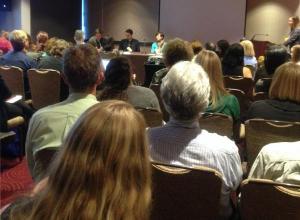By Sarah Scoles
After Melinda Wenner Moyer’s son was diagnosed with sensory processing disorder, she wrote an article called “My Son Has a Disorder that May Not Exist” for Scientific American Mind. She struggled, though, with whether to include her actual son and their family’s actual story. While their experiences were the motivation for exploring this topic, she worried that he could later be discriminated against because of the article (or mocked by his peers when they learned how to Google). In the end, she and her editors decided to use his real identity in the print version but an alias in the immortal online text.Like Moyer, a parenting columnist at Slate, all of this session’s panelists have used their own experiences — and the once-forbidden “I” — to explore scientific topics. But figuring out when, why, and how to write in first-person isn’t always straightforward.
Moyer inserts her personal life into articles first to build rapport with her audience. When she tells them about a parenting gaffe, that says, “See? I make mistakes. I live in the real world, not just behind a screen.” She mostly enters her articles in bookend form, with reported science in the middle. That separation helps keep the science grounded. But including a 2D version of herself clues the reader in to her biases. “I am sure that my own experiences have tainted my analysis,” she said, “and I want to be open about that.”
Elie Dolgin, the news editor at Stat, agreed. When you come to a topic because of a personal experience, the article is fundamentally different from an idea that your editor assigned. Dolgin recently wrote a Nautlius article called “Stop Developing Drugs for the Cancer that Killed My Mother.” He, his connection to the story, and even the summary of his whole story live in just the title. When his mother was diagnosed, he did what he always did: “I came at it from an objective science journalist standpoint,” reading papers and digging into clinical trials. But the story wouldn’t have existed without his mother. So, he said, “to give perspective, I had to give my journey.”
Wen Stephenson, an independent journalist and author of the book “What We’re Fighting for Now Is Each Other,” also includes himself in his writing to illuminate motivations and biases. After years of writing about climate change, the science “radicalized” him. He included the story of his radicalization in the 2011 Slate articles “Walking Home from Walden” and “The Moment I Realized I Had to Do Something,” which eventually became the prologue to his book. His emotions were important to his story. And although “emotion isn’t intellectually respectable,” he said, “we need to be fully human.”
But only include your personal experiences and emotions, Moyer warned, when they are authentic. Don’t gin up an anecdote. Be up-front in the pitch, Dolgin said, about how — and how much — you plan to include yourself. And the answer to “How much?” shouldn’t be “Too much.” Dip into your story only for a good reason, and jump out when you’ve made your point. Because “me, me, me” is different from “This happened to me, and here’s why it matters.”




